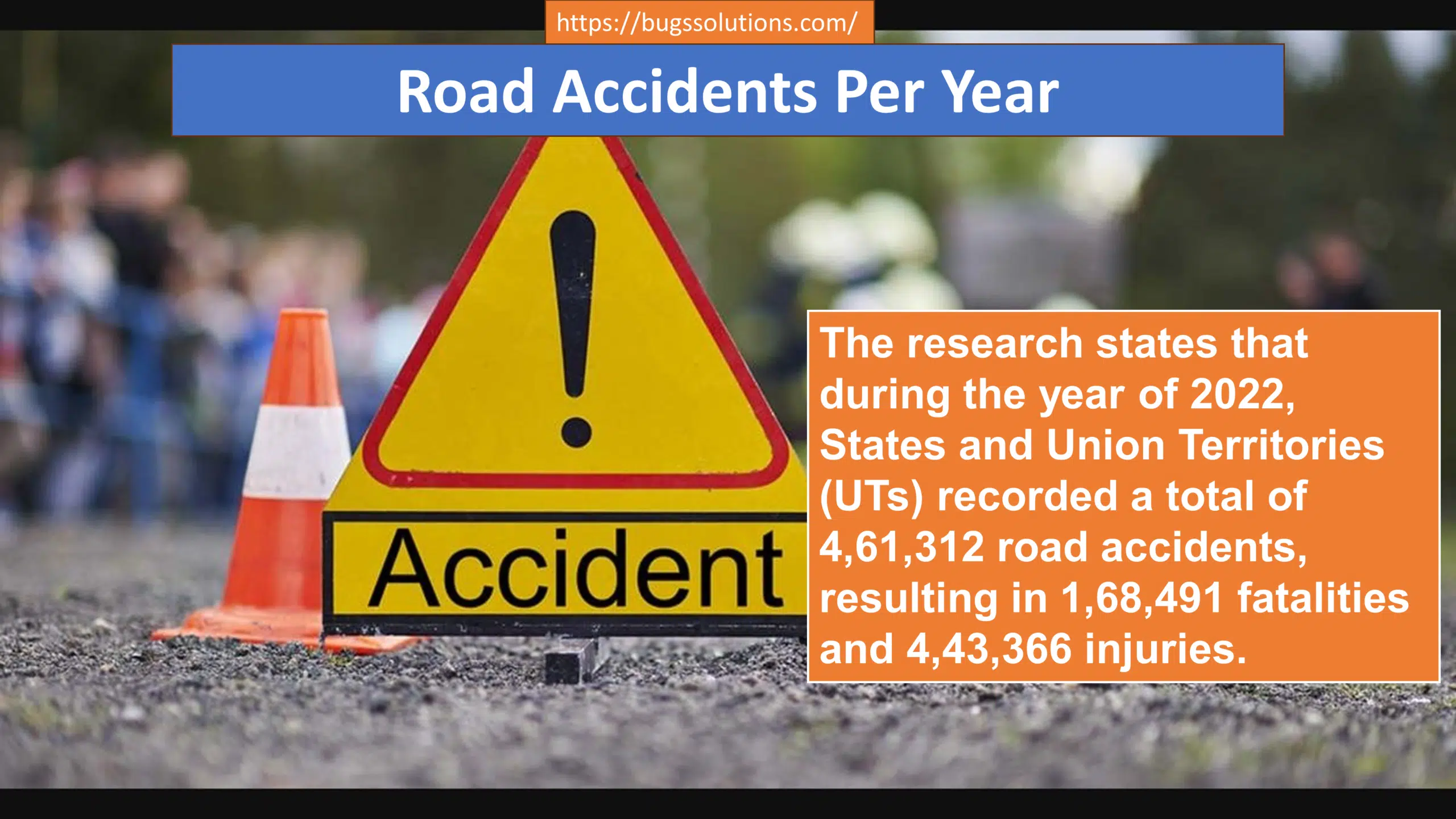Ministry of Road Transport and Highways Releases Annual Report on ‘Road Accidents in India-2022’
The annual report on ‘Road Accidents in India-2022’ has been published by the Ministry of Road Transport and Highways. This report is based on the data/information received from police departments of states/UTs on a calendar year basis in standardized formats as provided by the United Nations Economic and Social Commission for Asia and the Pacific (UNESCAP) under the Asia Pacific Road Accident Data (APRAD) base project.
Key Findings of the Report
According to the report, a total of 4,61,312 road accidents have been reported by states and union territories (UTs) during the calendar year 2022, which claimed 1,68,491 lives and caused injuries to 4,43,366 persons. This marks an increase of 11.9% in accidents, 9.4% in fatalities, and 15.3% in injuries compared to the previous year.
Urgent Need for Comprehensive Approach
The report underscores the urgency of adopting a comprehensive approach to address the contributing factors to these accidents, including speeding, reckless driving, drunken driving, and non-compliance with traffic regulations. It is crucial that we strengthen enforcement mechanisms, enhance driver education and training programs, and invest in improving the condition of roads and vehicles.
Also Read : 8 Tire Brands You Should Definitely Avoid Purchasing in Us
The Ministry is committed to implementing robust measures to curb road accidents. It is also working towards various aspects such as road user behavior, road infrastructure, vehicle standards, enforcement of traffic regulations, and the role of technology in accident prevention. As road accidents are multi-causal in nature, they require a multi-pronged approach to mitigate the problems through concerted efforts of all agencies at both central government and state governments.
Multi-Pronged Strategy for Road Safety
The Ministry, along with various other related organizations as well as stakeholders, has formulated a multi-pronged strategy to address the issue of road safety focusing on all 4Es including education, engineering (both roads and vehicles), enforcement, and emergency care. Furthermore, the Ministry is actively involved in initiatives such as the implementation of modern transportation systems, road safety audits, and international collaborations to learn from global best practices.
Initiatives like the Electronic Detailed Accident Report (E-DAR) for real-time data analysis and automated vehicle inspection centers are also underway to combat road accidents.
Significance of the Report
The “Road Accidents in India-2022” publication serves as a valuable resource for policymakers, researchers, and stakeholders in the realm of road safety. It offers in-depth insights into various aspects of road accidents, including their causes, locations, and their impact on different categories of road users. The report also sheds light on emerging trends, challenges, and the Ministry’s road safety initiatives.
Collaborative Efforts to Enhance Road Safety
The “Road Accidents in India-2022” publication serves as a valuable resource for policymakers, researchers, and stakeholders in the realm of road safety. It offers in-depth insights into various aspects of road accidents, including their causes, locations, and their impact on different categories of road users. The report also sheds light on emerging trends, challenges, and the Ministry’s road safety initiatives.
To address the complex and multifaceted issue of road safety, the Ministry of Road Transport and Highways has been collaborating with various stakeholders, including state governments, law enforcement agencies, vehicle manufacturers, and civil society organizations. These collaborative efforts aim to ensure a comprehensive and coordinated approach to enhancing road safety across the country.
Strengthening Enforcement and Compliance
One of the key focus areas of the Ministry’s road safety strategy is strengthening enforcement and compliance with traffic regulations. The Ministry has been working closely with state police departments to enhance the capacity and effectiveness of law enforcement agencies in monitoring and penalizing traffic violations.
This includes the deployment of advanced technologies, such as speed cameras, red-light violation detection systems, and automated number plate recognition, to improve the detection and deterrence of traffic offenses. Additionally, the Ministry has been advocating for the adoption of stricter penalties and demerit point systems to ensure that there are tangible consequences for reckless and irresponsible driving behavior.
The Ministry has also been collaborating with state governments to enhance the training and skill development of traffic police personnel. This includes programs focused on evidence-based enforcement techniques, accident investigation, and data analysis to better target high-risk areas and driver behaviors.
Enhancing Driver Education and Training
Recognizing the crucial role of driver behavior in road safety, the Ministry of Road Transport and Highways has been placing a strong emphasis on improving driver education and training programs across the country.
The Ministry has been working with driving schools, training institutes, and state transport departments to standardize and upgrade the curriculum for both theoretical and practical driving lessons. This includes the incorporation of modules on road safety, defensive driving techniques, and the importance of complying with traffic rules and regulations.
Additionally, the Ministry has been exploring the use of advanced driving simulators and interactive learning tools to enhance the quality and effectiveness of driver training programs. These technologies not only allow for the practice of safe driving in a controlled environment but also help to instill better risk perception and decision-making skills among learner drivers.
The Ministry has also been advocating for the strengthening of licensing procedures to ensure that only competent and responsible drivers are granted the privilege to operate motor vehicles on Indian roads.
Improving Road Infrastructure and Design
The condition and design of road infrastructure play a crucial role in road safety. The Ministry of Road Transport and Highways has been working closely with state governments and local authorities to enhance the quality and safety of the road network across the country.
This includes initiatives to address infrastructural deficiencies, such as the construction of safer intersections, the installation of guardrails and barriers, the improvement of road signage and markings, and the implementation of traffic calming measures in high-risk areas.
Additionally, the Ministry has been promoting the adoption of road safety audits at various stages of road development and maintenance. These audits help to identify potential hazards and design flaws, enabling the implementation of corrective measures to enhance the overall safety of the road network.
The Ministry has also been exploring the use of advanced technologies, such as intelligent transportation systems and connected vehicles, to improve the integration and management of road infrastructure. These technologies can help to optimize traffic flow, provide real-time information to drivers, and enhance the overall safety and efficiency of the transportation system.
International Collaboration and Knowledge-Sharing
Road safety is a global challenge, and the Ministry of Road Transport and Highways has been actively engaged in international collaborations and knowledge-sharing initiatives to learn from global best practices and foster the exchange of innovative solutions.
The Ministry has been participating in various international forums and platforms, such as the United Nations Road Safety Collaboration and the Global Road Safety Partnership, to share India’s experiences, challenges, and the measures being taken to address road safety issues.
These collaborative efforts have enabled the Ministry to learn from the successful strategies and interventions implemented in other countries, and to adapt and implement them in the Indian context. This includes the adoption of proven road safety management practices, the implementation of evidence-based policies and programs, and the utilization of cutting-edge technologies for accident prevention and data analysis.
Furthermore, the Ministry has been actively engaged in bilateral and multilateral partnerships with other countries, research institutions, and international organizations to facilitate the exchange of knowledge, expertise, and best practices in the field of road safety. These collaborations have not only enriched the Ministry’s understanding of the global road safety landscape but have also enabled the development of collaborative solutions to address the unique challenges faced by India.
Conclusion
The release of the “Road Accidents in India-2022” report by the Ministry of Road Transport and Highways underscores the urgent need for a comprehensive and coordinated approach to addressing the growing challenge of road accidents in the country. The report’s key findings, highlighting the alarming increase in accidents, fatalities, and injuries, serve as a wake-up call for all stakeholders to take immediate and decisive action.
The Ministry’s multifaceted efforts, encompassing strengthened enforcement, enhanced driver education, improved road infrastructure, upgraded vehicle safety standards, and the leverage of cutting-edge technologies, demonstrate a strong commitment to combating the road safety crisis. However, the task at hand requires the concerted efforts of all stakeholders, including state governments, law enforcement agencies, civil society organizations, and the general public, to effectively address the various contributing factors to road accidents.
By working together and learning from global best practices, India can make significant strides in improving road safety, reducing the loss of lives, and ensuring that its transportation network becomes a model of safety, efficiency, and sustainability for the rest of the world to emulate. The “Road Accidents in India-2022” report serves as a valuable resource and a call to action for all those dedicated to creating safer roads and communities in the years to come.










